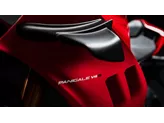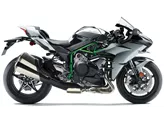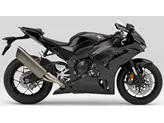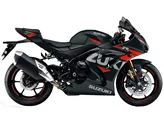Kawasaki Ninja ZX-10R 2016 vs. BMW S 1000 RR 2015

Kawasaki Ninja ZX-10R 2016

BMW S 1000 RR 2015
Vue d’ensemble - Kawasaki Ninja ZX-10R 2016 vs BMW S 1000 RR 2015
The Kawasaki Ninja ZX-10R 2016 and the BMW S 1000 RR 2015 are both high-performance supersport motorcycles that offer impressive specifications and features.
In terms of engine and drivetrain, both bikes have an inline four-cylinder engine with similar displacement. The Kawasaki Ninja ZX-10R has a slightly smaller bore and stroke compared to the BMW S 1000 RR, but it still manages to produce slightly more horsepower at 200.1 HP compared to the BMW's 199 HP. The torque figures are also similar, with the Kawasaki producing 114.3 Nm and the BMW producing 113 Nm. Both bikes have a compression ratio of 13 and come equipped with a 6-speed transmission.
In terms of suspension, both bikes feature a swingarm rear suspension. However, the Kawasaki Ninja ZX-10R comes with an upside-down telescopic fork front suspension, while the BMW S 1000 RR has a telescopic fork front suspension. This difference in suspension design may result in slightly different handling characteristics.

Kawasaki Ninja ZX-10R 2016
Both bikes have an aluminum frame, which provides a lightweight yet rigid structure. This helps improve handling and stability at high speeds.
When it comes to braking, both bikes are equipped with double disc brakes at the front. The Kawasaki Ninja ZX-10R features radial, petal technology brakes, while the BMW S 1000 RR has radial brakes. Both bikes offer excellent braking performance.
In terms of dimensions and weights, both bikes have the same front and rear tire widths and diameters. The Kawasaki Ninja ZX-10R has a slightly shorter wheelbase at 1415 mm compared to the BMW S 1000 RR's 1425 mm. The seat height is also slightly lower on the Kawasaki at 813 mm compared to the BMW's 815 mm. Both bikes have a fuel tank capacity of around 17 liters.
Now let's discuss the strengths and weaknesses of each bike. The Kawasaki Ninja ZX-10R 2016 has a great chassis geometry, which contributes to its excellent handling and stability. It also comes with high-quality chassis components, ensuring a smooth and comfortable ride. The brakes on the Kawasaki are also highly praised for their performance. Additionally, the Ninja ZX-10R is equipped with a wide range of electronics, including traction control, ABS, and multiple riding modes, enhancing the overall riding experience.

BMW S 1000 RR 2015
On the other hand, the BMW S 1000 RR 2015 has a superb shift assistant, which allows for quick and seamless gear changes. The engine on the BMW is incredibly powerful and rev-happy, providing exhilarating acceleration. The S 1000 RR also offers a great range of accessories, allowing riders to customize their bike to their preferences. Furthermore, the BMW comes with a race-ready data logging tool and calibration tool, which can be useful for professional riders.
In terms of weaknesses, the Kawasaki Ninja ZX-10R 2016 has a cockpit that may not be optimal for readability, which could be a minor inconvenience for some riders. On the other hand, the BMW S 1000 RR 2015 has a chassis that may reach its limit quickly in the hands of professional riders, potentially limiting its performance in certain situations.
Overall, both the Kawasaki Ninja ZX-10R 2016 and the BMW S 1000 RR 2015 are impressive motorcycles with their own strengths and weaknesses. Riders looking for a bike with excellent handling and a wide range of electronics may prefer the Kawasaki, while those seeking a bike with a powerful engine and a range of accessories may lean towards the BMW. Ultimately, the choice between these two bikes will depend on the individual rider's preferences and priorities.
Caractéristiques techniques Kawasaki Ninja ZX-10R 2016 par rapport à BMW S 1000 RR 2015
Avantages et inconvénients en comparaison
Avantages et inconvénients en comparaison
Kawasaki Ninja ZX-10R 2016

La ZX-10R Ninja a une certaine majesté, lors du premier roulage elle semble très stable, il faut la forcer un peu dans le rayon. Mais après quelques tours, cet effet se transforme en une incroyable précision qui permet de suivre une ligne bien ciblée. Le moteur est maintenant vraiment devenu sensiblement plus puissant et fait de la Kawa un énorme paquet global qui ne peut pas seulement plaire aux fans inconditionnels de Kawasaki. Le contrôle de traction se distingue de manière particulièrement positive sur la Kawa, il régule de manière très sensible. On peut même régler le frein moteur - elle ne manque donc certainement pas de fonctionnalités électroniques. La ZX-10R est la seule Superbike à être compatible avec la norme Euro4 dès 2016 !
BMW S 1000 RR 2015

Avec des faits concrets, la BMW peut encore marquer des points en 2015. Si vous aimez les performances de pointe, vous devez acheter la BMW. Elle vire en haut avec une puissance incroyable et distancie le reste du peloton dès 200. Les pilotes grands et lourds pourront en profiter encore plus. BMW n'a pas choisi la facilité avec cette machine et a mis sur pied une moto très universelle. Si l'on faisait un test comparatif avec 50 pilotes différents (du rookie au professionnel), la BMW obtiendrait la meilleure moyenne de toutes les motos de 1000 cm3. Le châssis électronique, mais aussi les aides à la conduite, permettent aux professionnels d'aller vite et aux débutants de rouler en toute sécurité. Une recommandation top pour un groupe cible très large. Les pilotes amateurs très rapides ne seront pas satisfaits à 100% par le châssis de série. Ceux qui ne souhaitent pas modifier le châssis devraient plutôt se tourner vers une R1M, une Panigale S ou encore une RSV RF. Quant à ceux qui modifient de toute façon leur moto, ils trouveront avec la S 1000 RR la base la plus puissante et la plus universelle. De manière surprenante, cette machine à la puissance d'ours se comporte également très bien sur les routes de campagne. Dans l'ensemble, cela ressemble à un compromis, mais dans la pratique, ce n'est jamais le cas.
Comparaison des prix Prix moyen du marché Kawasaki Ninja ZX-10R vs BMW S 1000 RR
There are a few key differences between a Kawasaki Ninja ZX-10R 2016 and a BMW S 1000 RR 2015. In terms of price, the actual average price of a Kawasaki Ninja ZX-10R 2016 is about 38% higher. A Kawasaki Ninja ZX-10R 2016 experiences a loss of 1,650 USD in one year and 1,600 USD in two years of ownership. This is offset by a loss of 1,560 USD and 840 USD for a BMW S 1000 RR 2015. Compared to BMW S 1000 RR 2015 there are less Kawasaki Ninja ZX-10R 2016 bikes available on the 1000PS.de Marketplace, specifically 4 compared to 8. It takes less time to sell a BMW S 1000 RR with 77 days compared to 100 days for the Kawasaki Ninja ZX-10R. Since model year 2005 1000PS.de editors have written 51 reviews for the Kawasaki Ninja ZX-10R and 135 reviews for the BMW S 1000 RR since model year 2010. The first review for the Kawasaki Ninja ZX-10R was published on 1/11/2004 and now has more than 2,900 views. This compares to more than 4,000 views for the first review on BMW S 1000 RR published on 4/16/2008.

















